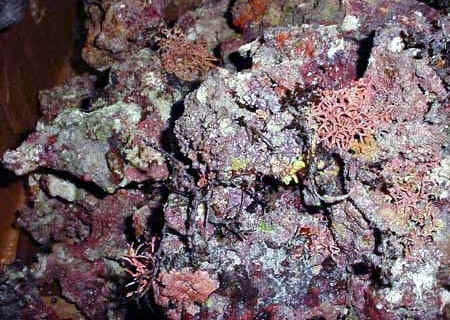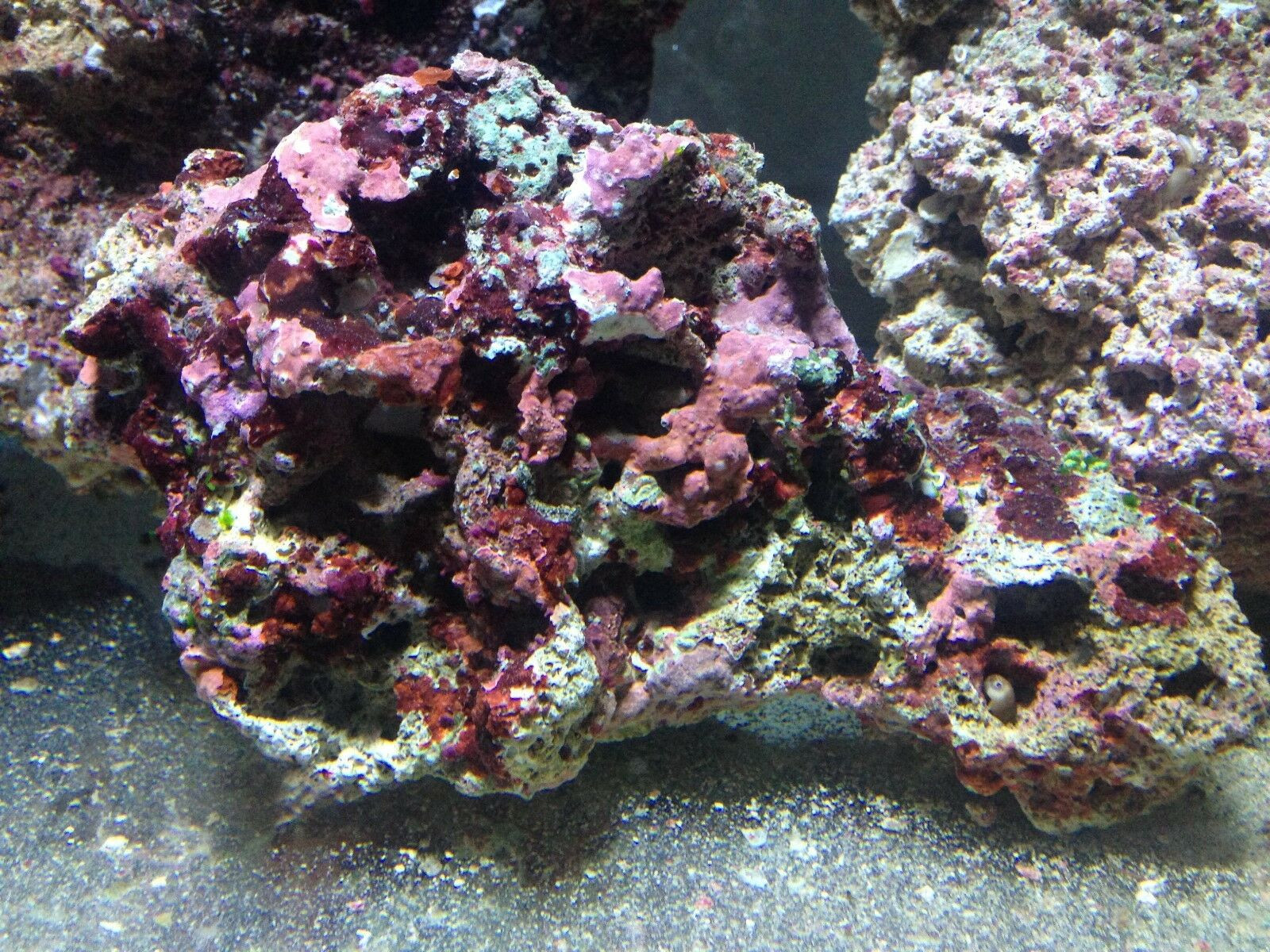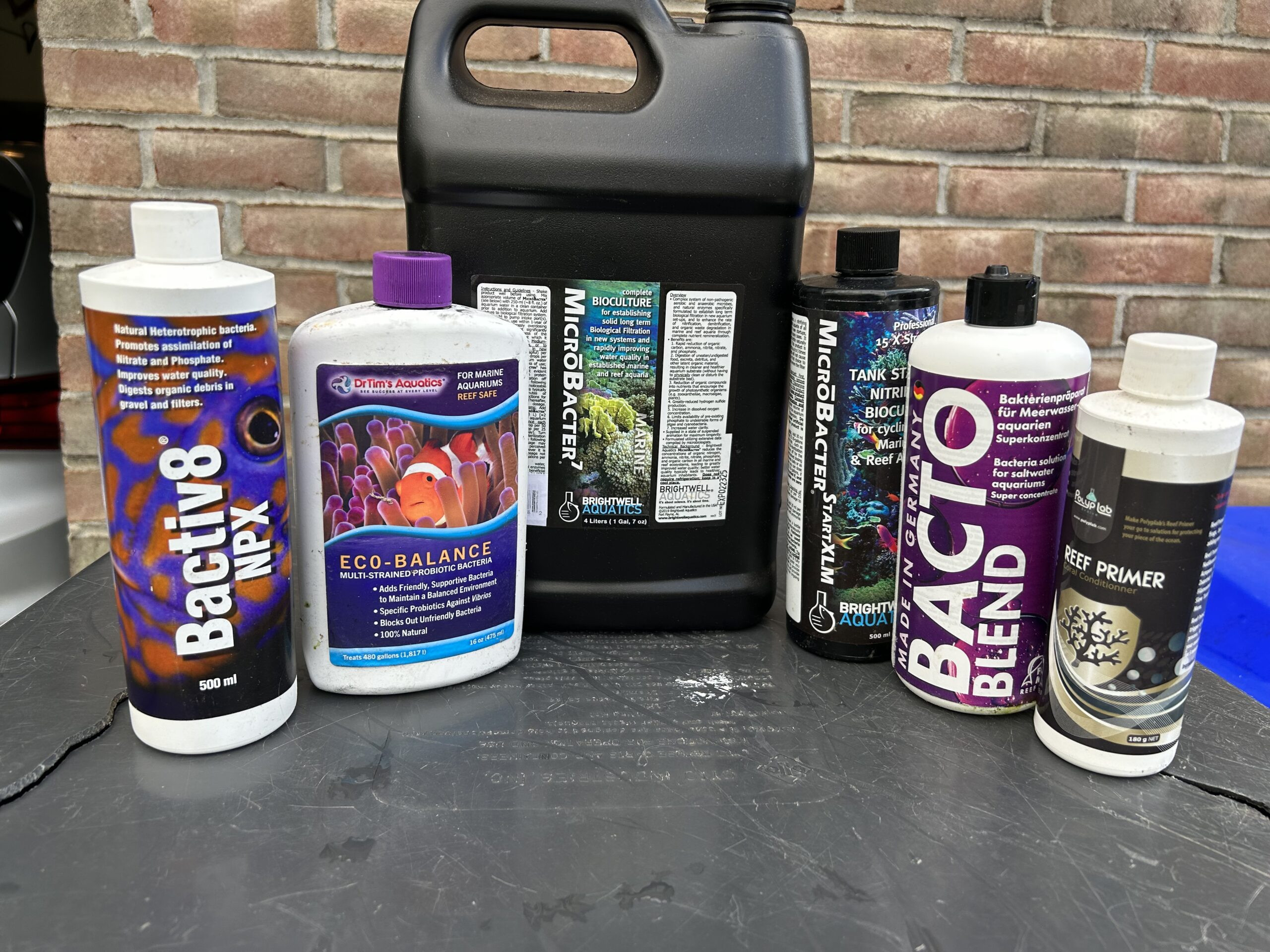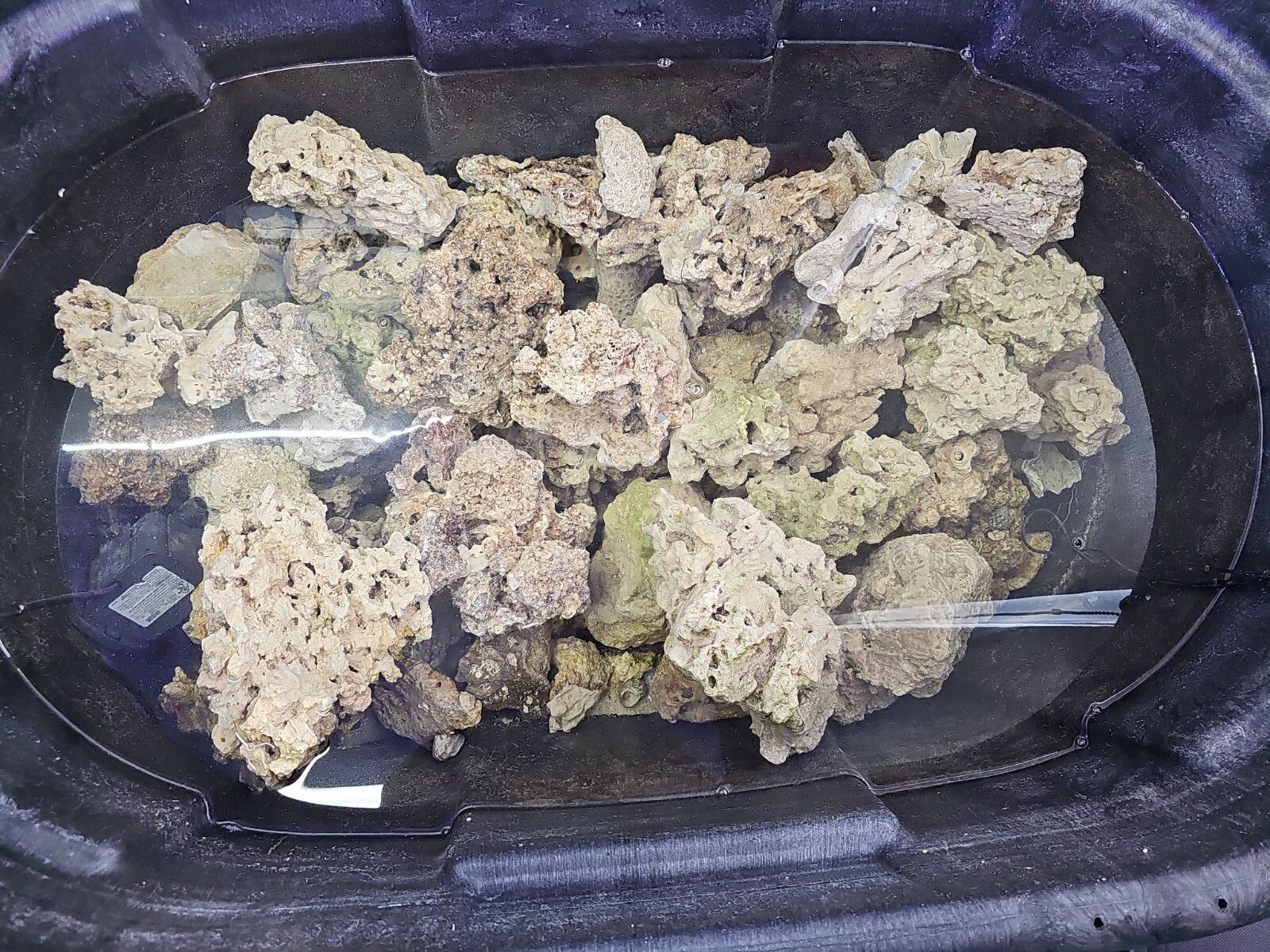Curing live rock is crucial for a healthy reef aquarium, and rockscapes.net offers expert guidance. This process removes unwanted organisms and establishes a beneficial biological filter. With the right techniques, you can create a vibrant and stable environment for your corals and fish. Rockscapes.net will help you achieve crystal-clear water, stable parameters and an ecosystem teeming with life, all crucial elements of a reef tank.
1. What Is Live Rock and Why Does It Need Curing?
Live rock is more than just a piece of stone; it’s a complex ecosystem teeming with beneficial bacteria, algae, and small organisms, and curing it is essential to avoid disaster. This rock, typically harvested from the ocean, acts as a natural biological filter in a saltwater aquarium. These rocks provides surface area for beneficial bacteria that convert harmful ammonia and nitrite into less toxic nitrate. However, live rock also contains dead or dying organisms that release ammonia, phosphates, and other undesirable substances into the water. The curing process removes these pollutants, ensuring a stable and healthy environment for your reef inhabitants.
What Are the Benefits of Curing Live Rock Properly?
Properly cured live rock offers several key advantages:
- Reduced Ammonia and Nitrite: Curing removes decaying organic matter, preventing spikes in toxic ammonia and nitrite levels.
- Stable Biological Filter: A well-cured rock establishes a stable population of beneficial bacteria, essential for long-term water quality.
- Minimized Algae Blooms: By removing excess nutrients, curing helps prevent nuisance algae blooms that can smother corals.
- Healthier Reef Environment: Cured live rock creates a more stable and hospitable environment for fish, corals, and invertebrates.
2. What Are the Two Main Types of Live Rock?
The two main types of rock are wet (or “live”) rock and dry rock, each requiring different curing methods. Wet rock is rock that has been recently collected from the ocean and is teeming with living organisms. Dry rock, on the other hand, is rock that has been dried out and is devoid of most living organisms.
What Are the Differences Between Wet and Dry Rock?
Here’s a breakdown of the key differences:
| Feature | Wet Rock (Live Rock) | Dry Rock |
|---|---|---|
| Living Organisms | Abundant; includes beneficial bacteria, algae, etc. | Minimal to none |
| Nutrients | High; contains decaying organic matter | Low |
| Curing Time | Typically shorter | Typically longer |
| Risk of Pests | Higher; may introduce unwanted organisms | Lower; reduces the risk of introducing pests |
| Cost | Often more expensive | Generally less expensive |
 Live rock teeming with life
Live rock teeming with life
3. How Do You Cure Wet Live Rock?
Curing wet rock involves removing dead and decaying organisms while preserving the beneficial bacteria. This process requires careful monitoring and regular water changes to maintain water quality.
What Are the Steps for Curing Wet Live Rock?
Here’s a step-by-step guide:
- Initial Inspection and Cleaning: Remove any visible dead organisms, algae, or unwanted pests like aiptasia anemones. Scrub the rock gently with a brush to remove loose debris.
- Curing Container Setup: Place the rock in a container filled with saltwater made from RO/DI water. Use a container large enough to hold all the rock without stacking it too tightly.
- Water Circulation and Temperature: Add powerheads to create strong water circulation around the rock. Maintain the water temperature between 75-80°F (24-27°C) using a heater.
- Protein Skimming: Use a protein skimmer to remove excess nutrients and dissolved organic compounds released from the rock.
- Regular Water Testing: Test the water for ammonia, nitrite, and nitrate levels two to three times per week. High ammonia levels indicate that the curing process is still underway.
- Water Changes: Perform a 100% water change when ammonia levels exceed 5-6 ppm. Continue with regular water changes (every 5-7 days) until ammonia and nitrite levels consistently read 0 ppm, and nitrate levels stop rising.
What Equipment Do You Need to Cure Live Rock?
- Curing Container: A plastic tub or spare aquarium is ideal.
- Saltwater: Made from RO/DI water and a high-quality salt mix.
- Powerheads: For water circulation.
- Heater: To maintain the correct temperature.
- Protein Skimmer: To remove organic waste.
- Test Kits: For ammonia, nitrite, and nitrate.
- Brush: A hard-bristled brush for cleaning the rock.
 Good quality cured live rock
Good quality cured live rock
How Long Does It Take To Cure Wet Live Rock?
The curing process for wet rock can take anywhere from one week to several months. The duration depends on the quality of the rock, how it was shipped, and the temperature of the curing chamber. Patience is key, as rushing the process can lead to problems later on.
What Are the Signs That Wet Live Rock Is Fully Cured?
The rock is fully cured when ammonia and nitrite levels consistently read 0 ppm, and nitrate levels stop rising. The rock should also have a clean, earthy smell, rather than a foul odor.
4. How Do You Cure Dry Live Rock?
Curing dry rock involves sterilizing the rock and then cycling it to establish a beneficial bacteria population. This process takes longer than curing wet rock, but it reduces the risk of introducing unwanted pests and parasites.
What Are the Steps for Curing Dry Live Rock?
Here’s how to cure dry rock effectively:
- Bleach Treatment (Optional): Some hobbyists recommend soaking dry rock in a dilute bleach solution (600-700 ml of unscented bleach per 10 liters of RO/DI water) for 7-10 days to kill any remaining organic matter. If you choose to do this, ensure thorough rinsing afterward.
- Rinsing: Rinse the rock thoroughly with clean saltwater to remove any residual bleach or other contaminants.
- Cycling Container Setup: Place the rock in a container filled with saltwater made from RO/DI water.
- Water Circulation and Temperature: Add powerheads to create strong water circulation around the rock. Maintain the water temperature between 75-80°F (24-27°C) using a heater.
- Adding Bacteria: Introduce beneficial bacteria to the tank using bottled bacteria products or by adding substrate from an established tank.
- Ammonia Source: Introduce an ammonia source, such as ammonia hydroxide, a pinch of fish food, or a piece of frozen shrimp, to feed the bacteria.
- Regular Water Testing: Test the water for ammonia, nitrite, and nitrate levels every other day.
- Ammonia Dosing: Continue adding ammonia until ammonia and nitrite levels consistently read 0 ppm. Then, double the amount of ammonia and repeat the process.
- Water Changes: Perform a 50-100% water change after one month to remove any accumulated detritus.
- Second Cycle (Recommended): Introduce previously cured wet rock to the dry rock tank to further inoculate the dry rock with beneficial organisms.
What About Using Vinegar to Cure Dry Rock?
Many hobbyists advocate using vinegar (acetic acid) to leach phosphates from dry rock. Here’s how:
- Vinegar Soak: Submerge the dry rock in a solution of water and vinegar (aim for a pH of around 4.0).
- Monitor pH: Regularly check and adjust the pH to maintain the acidity.
- Soak Time: Soak for several weeks, changing the vinegar solution periodically.
- Thorough Rinse: After soaking, rinse the rock extensively with fresh water before beginning the cycling process.
According to research from Arizona State University’s School of Earth and Space Exploration, prolonged exposure to acidic conditions can effectively dissolve phosphate compounds, making them easier to remove.
 Caribbean live rock brings bacteria, sponges, microfauna, and coralline algae
Caribbean live rock brings bacteria, sponges, microfauna, and coralline algae
How Long Does It Take To Cure Dry Live Rock?
The cycling process for dry rock can take several weeks to months. The duration depends on the amount of rock, the efficiency of the bacteria, and the amount of ammonia added.
What Are the Signs That Dry Live Rock Is Fully Cured?
The rock is fully cycled when ammonia and nitrite levels consistently read 0 ppm after adding a significant amount of ammonia. Nitrate levels should also be present, indicating that the nitrogen cycle is complete.
5. Can You Combine Wet and Dry Rock?
Yes, combining wet and dry rock can offer the best of both worlds. The wet rock provides a source of beneficial bacteria and other organisms, while the dry rock provides a stable base with less risk of introducing pests.
What Are the Benefits of Combining Wet and Dry Rock?
- Faster Cycling: Wet rock helps to seed the dry rock with beneficial bacteria, speeding up the cycling process.
- Reduced Risk of Pests: Dry rock minimizes the risk of introducing unwanted organisms.
- Enhanced Biodiversity: The combination of wet and dry rock can create a more diverse and resilient ecosystem.
How Should You Combine Wet and Dry Rock?
Place the wet rock in direct contact with the dry rock to allow the bacteria and other organisms to colonize the dry rock more quickly. Aim for at least 10% of the rock used to be wet live rock.
6. What Are Common Mistakes To Avoid When Curing Live Rock?
Avoiding common mistakes is crucial for successful curing.
What Mistakes Should You Avoid When Curing Live Rock?
- Rushing the Process: Patience is essential. Rushing the curing process can lead to unstable water parameters and problems with your reef inhabitants.
- Using Tap Water: Tap water can contain chloramines, phosphates, and other harmful substances that can disrupt the curing process. Always use RO/DI water.
- Insufficient Water Circulation: Adequate water circulation is necessary to distribute nutrients and oxygen to the bacteria.
- Ignoring Water Testing: Regular water testing is essential to monitor the progress of the curing process and make necessary adjustments.
- Overdosing Ammonia: Adding too much ammonia can overwhelm the bacteria and stall the cycling process. Start with small amounts and gradually increase as needed.
 Some of the bottled bacteria the author has used to cycle dry rock
Some of the bottled bacteria the author has used to cycle dry rock
7. How Can You Accelerate the Curing Process?
While patience is key, there are some strategies to expedite the curing process safely.
What Are Safe Methods to Speed Up Live Rock Curing?
- Use a High-Quality Protein Skimmer: Efficient protein skimming removes organic waste, reducing the bioload and accelerating the nitrogen cycle.
- Maintain Optimal Temperature: Keeping the water temperature consistently between 75-80°F (24-27°C) promotes bacterial growth.
- Seed with Established Media: Introducing a small amount of substrate or filter media from a healthy, established aquarium can jumpstart the colonization of beneficial bacteria.
- Use Bottled Bacteria Additives: Commercial bacteria additives can introduce diverse strains of beneficial bacteria to the rock.
8. How Does Curing Live Rock Impact Aquascaping?
The shape, size, and arrangement of live rock not only affect the aesthetics of your aquarium but also influence water flow, create habitats, and provide surfaces for coral growth.
How Do You Aquascape with Cured Live Rock Effectively?
- Plan Ahead: Sketch out your desired aquascape before placing any rock.
- Consider Stability: Ensure the rock structure is stable and won’t topple over.
- Create Flow: Arrange the rock to promote good water circulation throughout the tank.
- Provide Shelters: Create caves and crevices for fish and invertebrates to hide.
- Maximize Surface Area: Arrange the rock to maximize the surface area available for coral growth.
9. How Do You Maintain Live Rock After Curing?
Proper maintenance is essential to keep your live rock healthy and functioning optimally.
What Are the Best Practices for Maintaining Cured Live Rock?
- Regular Water Changes: Perform regular water changes (10-20% every 1-2 weeks) to maintain water quality.
- Detritus Removal: Remove any accumulated detritus from the rock using a siphon or turkey baster.
- Maintain Good Water Flow: Ensure adequate water circulation to prevent dead spots and promote oxygenation.
- Control Algae Growth: Manage algae growth by maintaining proper nutrient levels and introducing algae-eating invertebrates.
10. Where Can You Find High-Quality Live Rock in the USA?
Sourcing high-quality live rock is crucial for a successful reef aquarium.
Where To Purchase Live Rock From USA?
While specific recommendations can vary, consider these options:
- Local Fish Stores (LFS): Many reputable LFSs specialize in saltwater aquariums and offer live rock.
- Online Vendors: Several online vendors specialize in live rock, offering a wide selection and convenient shipping.
- Aquarium Clubs: Local aquarium clubs can be a great resource for finding hobbyists who are selling or trading live rock.
When purchasing live rock, look for rock that is well-cured, free of pests, and has a healthy appearance. Rockscapes.net may provide guidance on reputable suppliers and what to look for when selecting your live rock.
Rockscapes.net is your go-to source for all things related to creating stunning rockscapes. Whether you’re looking for design inspiration, information on different types of rocks, or expert advice on installation and maintenance, Rockscapes.net has you covered.
Address: 1151 S Forest Ave, Tempe, AZ 85281, United States
Phone: +1 (480) 965-9011
Website: rockscapes.net
 A large vessel like this rubbermaid trough makes a great receptacle for curing live rock
A large vessel like this rubbermaid trough makes a great receptacle for curing live rock
FAQ About Curing Live Rock:
- Why is curing live rock important?
- Curing rock is important because it removes dead organisms and excess nutrients, preventing ammonia spikes and creating a stable biological filter for your reef aquarium.
- How long does it take to cure live rock?
- The curing process can take anywhere from one week to several months, depending on the type of rock and the conditions in the curing container.
- Can I use tap water to cure live rock?
- No, you should only use RO/DI water to cure rock, as tap water can contain harmful substances that can disrupt the process.
- What are the signs that live rock is fully cured?
- Rock is fully cured when ammonia and nitrite levels consistently read 0 ppm, and nitrate levels stop rising.
- Can I combine wet and dry rock in my aquarium?
- Yes, combining wet and dry rock can offer the best of both worlds by providing beneficial bacteria while minimizing the risk of pests.
- Do I need a protein skimmer to cure live rock?
- A protein skimmer is highly recommended, as it removes excess nutrients and dissolved organic compounds released from the rock.
- How often should I perform water changes during the curing process?
- Perform a 100% water change when ammonia levels exceed 5-6 ppm, and then continue with regular water changes every 5-7 days.
- What should I do if I see algae growing on my live rock during the curing process?
- Reduce lighting in the curing container and consider adding algae-eating invertebrates to help control algae growth.
- Can I use bleach to cure dry rock?
- Yes, a dilute bleach solution can be used to sterilize dry rock, but ensure thorough rinsing afterward.
- What is the ideal temperature for curing live rock?
- The ideal temperature for curing rock is between 75-80°F (24-27°C).
Whether you’re a seasoned reef keeper or just starting out, mastering the art of curing rock is essential for creating a thriving and beautiful reef aquarium. With the right techniques and a little patience, you can transform ordinary rock into a vibrant ecosystem teeming with life. For more inspiration and expert advice, visit rockscapes.net today and discover the endless possibilities of rockscapes.
